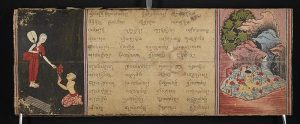 ABHIDHAMMA, the name of one of the three Pitakas, or baskets of tradition, into which the Buddhist scriptures are divided. It consists of seven works:
ABHIDHAMMA, the name of one of the three Pitakas, or baskets of tradition, into which the Buddhist scriptures are divided. It consists of seven works:
1. Dhamma Sangani (enumeration of qualities).
2. Vibhanga (exposition).
3. Katha Vatthu (bases of opinion).
4. Puggala Pannatti (on individuals).
5. Dhatu Katha (on relations of moral dispositions).
6. Yamaka (the pairs, that is, of ethical states).
7. Patthana (evolution of ethical states).
The approximate date of these works is probably from about 400 B.C. to about 250 B.C., the first being the oldest and the third the latest of the seven. Before the publication of the texts, when they were known only by hearsay, the term Abhidhamma was usually rendered “Metaphysics.” This is now seen to be quite erroneous. Dhamma (or dharma) means the doctrine, and Abhidhamma (or Abhidharma) has a relation to Dhamma similar to that of by-law to law. It expands, classifies, tabulates, draws corollaries from the ethical doctrines laid down in the more popular treatises. There is no metaphysics in it at all, only psychological ethics of a peculiarly dry and scholastic kind. And there is no originality in it; only endless permutations and combinations of doctrines already known and accepted. As in the course of centuries the doctrine itself, in certain schools, varied, it was felt necessary to rewrite these secondary works. This was first done, so far as is at present known, by the Sarvastivadins (Realists), who in the century before and after Christ produced a fresh set of seven Abhidhamma books. These are lost in India, but still exist in Chinese translations. The translations have been analysed in a masterly way by Professor Takakusu in the article mentioned below, They deal only with psychological ethics. In the course of further centuries these books in turn were superseded by new treatises; and in one school at least, that of the Maha-yana (great Vehicle) there was eventually developed a system of metaphysics. But the word Abhidhamma then fell out of use in that school, though it is still used in the schools that continue to follow the original seven books.
See Buddhist Psychology by Caroline Rhys Davids (London, 1900), translation of the Dhamma Sangani, with valuable introduction; or the Royal Asiatic Society, 1892, contains an abstract of the Katha “On the Abhidhamma books of the Sarvastivadins,” by Prof. Takakusu, in Journal of the Pali Text Society, 1905.
*******
Source: 1911 encyclopedia.
